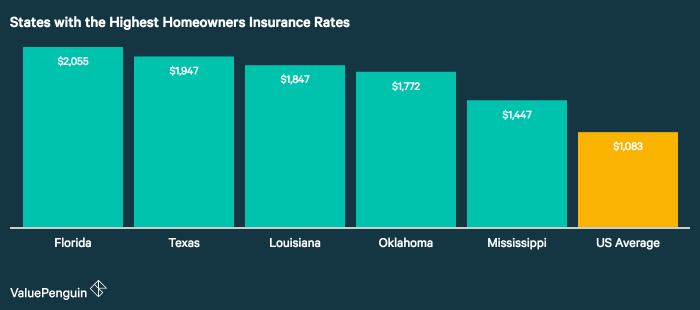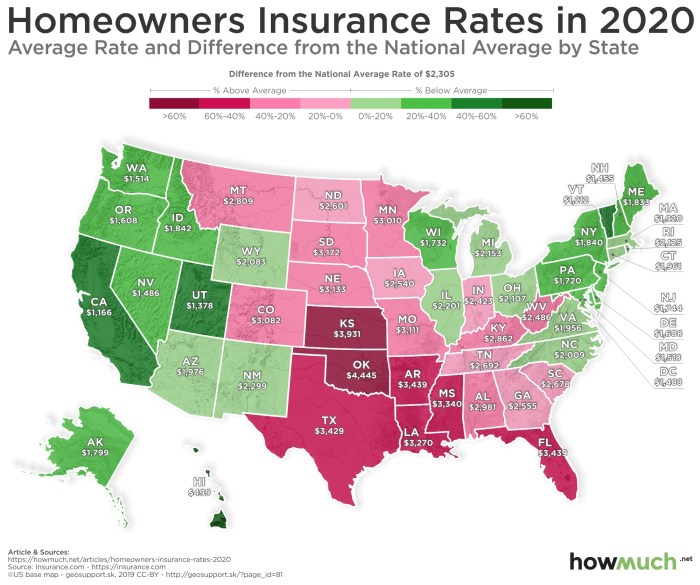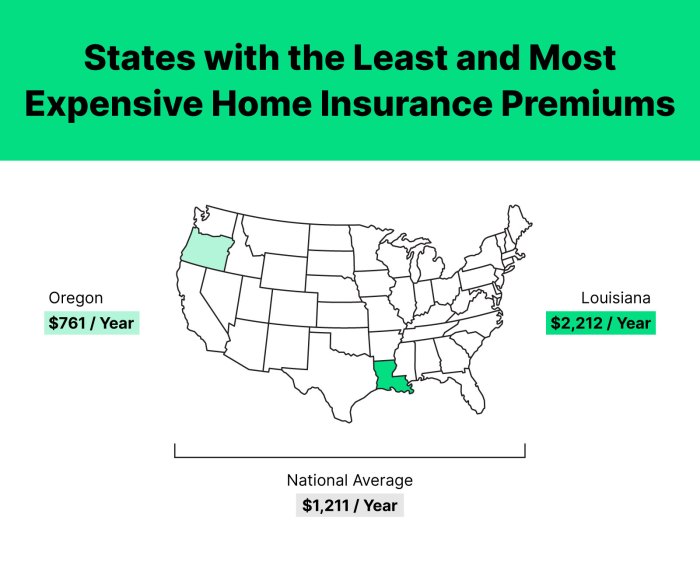Securing your home is a significant investment, and understanding the associated costs is crucial. Homeowners insurance protects your property and liability, but the price can vary dramatically depending on numerous factors. This guide delves into the complexities of average homeowners insurance costs, exploring the key elements that influence premiums and offering strategies to find affordable coverage.
From geographic location and home characteristics to coverage levels and personal financial history, a multitude of variables impact your insurance rate. Navigating this landscape can feel overwhelming, but with a clear understanding of the factors at play, you can make informed decisions to secure the best possible protection for your investment at a price that aligns with your budget. We will explore regional differences, policy types, and cost-saving strategies to empower you with the knowledge you need.
Factors Influencing Homeowners Insurance Costs

Several key factors significantly impact the cost of homeowners insurance. Understanding these factors can help you make informed decisions and potentially lower your premiums. This section will explore the primary influences on your insurance rate, allowing you to better understand your policy and its associated costs.
Location’s Impact on Homeowners Insurance Premiums
Geographic location is a major determinant of homeowners insurance premiums. Insurance companies assess risk based on factors like the frequency of natural disasters (hurricanes, earthquakes, wildfires), crime rates, and the proximity to fire hydrants or other emergency services. High-risk areas, such as those prone to hurricanes along the Gulf Coast or wildfire-prone regions in California, typically command higher premiums due to the increased likelihood of claims. Conversely, low-risk areas with lower crime rates and fewer natural disaster threats generally enjoy lower premiums. For example, a home in a hurricane-prone coastal area might pay significantly more than an identical home located inland in a less disaster-prone region. Similarly, a home in a neighborhood with a high crime rate will likely have higher premiums than one in a safer neighborhood.
Home Features and Their Influence on Insurance Costs
The characteristics of your home itself play a crucial role in determining your insurance costs. Older homes, for instance, may require more maintenance and be more susceptible to damage, resulting in higher premiums. Larger homes generally cost more to insure due to the increased replacement cost. The construction materials used also influence the cost; homes built with fire-resistant materials like brick or concrete typically have lower premiums compared to those built with wood.
| Feature | Impact on Cost | Example | Explanation |
|---|---|---|---|
| Age of Home | Older homes generally cost more | A 100-year-old Victorian vs. a newly built ranch | Older homes may have outdated plumbing or electrical systems, increasing the risk of damage. |
| Home Size | Larger homes cost more to insure | A 5,000 sq ft home vs. a 1,500 sq ft home | Larger homes require more materials to rebuild, increasing the replacement cost. |
| Construction Materials | Fire-resistant materials lower costs | Brick home vs. wood-frame home | Brick and concrete are less susceptible to fire damage. |
| Security Systems | Security systems can lower costs | Home with monitored alarm system vs. home without | Security systems reduce the risk of burglary and theft. |
Coverage Levels and Their Impact on Premiums
The amount of coverage you choose significantly affects your premium. Liability coverage protects you financially if someone is injured on your property. Dwelling coverage protects the structure of your home, while personal property coverage protects your belongings inside. Higher coverage amounts generally mean higher premiums. For example, choosing a $500,000 dwelling coverage will be more expensive than a $300,000 dwelling coverage. Similarly, increasing your liability coverage from $100,000 to $300,000 will also increase your premium, but provides greater financial protection. Choosing optional coverages like flood or earthquake insurance will also add to the overall cost.
Credit Score and Claims History’s Influence on Insurance Rates
Your credit score and claims history are significant factors in determining your insurance rates. Insurers often view a good credit score as an indicator of responsible financial behavior, potentially leading to lower premiums. Conversely, a poor credit score might result in higher premiums. Similarly, a history of frequent claims can significantly increase your premiums, as insurers perceive a higher risk of future claims.
Comparative Illustration:
Let’s imagine two homeowners with similar homes and coverage levels. Homeowner A has an excellent credit score (750+) and no claims in the past five years. Homeowner B has a poor credit score (below 600) and two claims in the past two years. Homeowner A might receive a significantly lower premium compared to Homeowner B. The exact difference would depend on the specific insurer and their rating algorithms, but it could be hundreds or even thousands of dollars annually.
Finding Affordable Homeowners Insurance

Securing affordable homeowners insurance requires a proactive approach and a thorough understanding of the market. By comparing quotes, leveraging discounts, and regularly reviewing your policy, you can significantly reduce your premiums without compromising coverage. This section details strategies to achieve these savings.
Obtaining competitive quotes from multiple insurance providers is crucial for finding the best value. The insurance market is competitive, and prices can vary significantly between companies. Don’t settle for the first quote you receive; shop around to ensure you’re getting the best possible deal.
Comparing Insurance Quotes
A systematic approach to comparing quotes is essential to avoid overlooking key details. The following steps will guide you through this process, helping you identify the best value for your needs.
- Gather Quotes: Contact at least three to five different insurance providers, providing them with consistent information about your property and coverage needs. This ensures a fair comparison.
- Standardize Coverage: Ensure that all quotes offer comparable coverage levels. Compare deductibles, liability limits, and coverage for specific perils (e.g., fire, wind, theft). Differences in coverage can significantly impact the premium.
- Analyze Premiums and Deductibles: Compare the total annual premiums for each quote. Consider the trade-off between higher premiums and lower deductibles. A higher deductible might result in lower premiums, but you’ll pay more out-of-pocket in the event of a claim.
- Review Policy Exclusions: Carefully examine each policy’s exclusions—what isn’t covered. Some policies may exclude certain types of damage or specific situations. Understanding these exclusions is critical to making an informed decision.
- Check Company Ratings: Research the financial stability and customer service ratings of each insurance provider. A reputable company with a strong financial rating will be more likely to pay claims promptly and fairly.
Bundling Homeowners and Auto Insurance
Bundling your homeowners and auto insurance policies with the same provider often leads to significant savings. Insurance companies offer discounts for bundling because it reduces their administrative costs and increases customer loyalty. These discounts can be substantial, representing a considerable reduction in your overall insurance expenses.
For example, a homeowner might pay $1,200 annually for homeowners insurance and $800 annually for auto insurance. Bundling these policies could result in a 15% discount, saving $300 annually ($1,200 + $800 = $2,000; 15% of $2,000 = $300).
Annual Policy Review and Updates
Regularly reviewing and updating your homeowners insurance policy is crucial to ensure you maintain adequate coverage and avoid paying for unnecessary protection. Life circumstances change, and these changes can impact your insurance needs and premiums.
Reasons for annual review include changes in your property value (due to renovations or market fluctuations), changes in your personal assets (acquisition of valuable items), and changes in your risk profile (e.g., installing a security system). By updating your policy annually, you can ensure you have the right coverage at the best possible price. Failing to do so could leave you underinsured or overpaying for coverage you no longer require.
Epilogue

Ultimately, the average cost of homeowners insurance is a complex figure, influenced by a wide range of interconnected variables. While a national average provides a general benchmark, it’s crucial to understand the nuances of your specific situation. By carefully considering location, home features, coverage needs, and financial history, and by actively comparing quotes from multiple insurers, you can secure a homeowners insurance policy that provides adequate protection at a price you can comfortably afford. Remember that regular review and adjustments to your policy are key to maintaining optimal coverage and cost-effectiveness.
Q&A
What is a homeowners insurance deductible?
Your deductible is the amount you pay out-of-pocket before your insurance coverage kicks in. Higher deductibles generally lead to lower premiums, while lower deductibles result in higher premiums.
How often should I shop for homeowners insurance?
It’s advisable to compare rates from different insurers annually, or at least every few years, to ensure you’re getting the best possible price and coverage. Your circumstances may change, impacting your insurance needs and available rates.
Does my credit score affect my homeowners insurance rate?
In many states, your credit score is a factor in determining your insurance premium. A higher credit score generally correlates with lower rates.
What is included in a standard homeowners insurance policy?
Standard policies typically cover dwelling coverage (damage to your home), personal property coverage (damage to your belongings), liability coverage (protecting you from lawsuits), and additional living expenses (if you can’t live in your home due to damage).
What are some ways to lower my homeowners insurance cost?
Consider increasing your deductible, improving home security (alarms, etc.), bundling policies (home and auto), and maintaining a good credit score. Shopping around for quotes is also crucial.